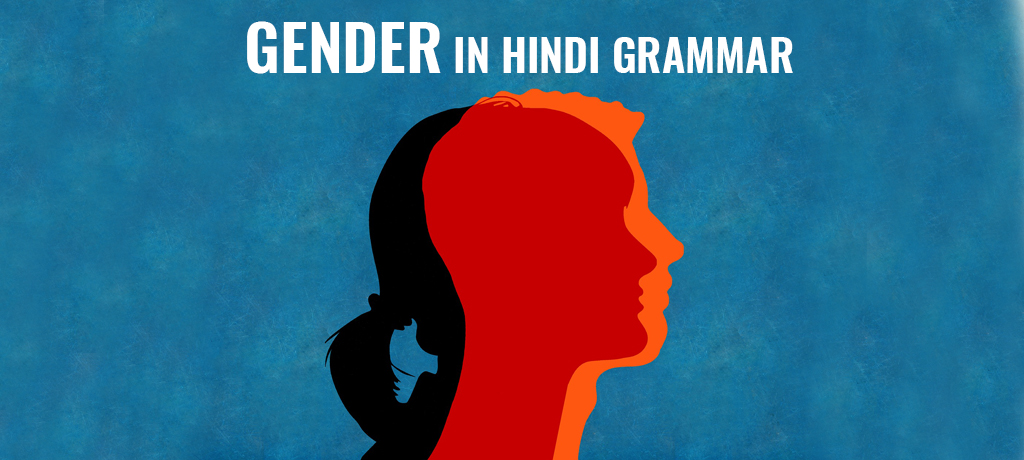In the Hindi language, a noun which indicates male is called a masculine gender and a noun which indicates female is called a feminine gender. Hindi nouns have two grammatical genders, masculine and feminine. There is no neutral gender in Hindi. It is important to know the gender of a word to decline [match a noun with its case] the noun and to modify other words which are grammatically related to the noun within a sentence.
Let’s understand the different nuances of genders one by one –
A. Masculine Nouns – for the noun words
We write masculine in two forms. One with singular “आ “ & plural “ए” and the other which has the same singular and plural form.
1. With singular “आ” & plural “ए”
| बेटा | “Son” | बेटे | “Sons |
| लड़का | “Boy” | लड़के | “Boys” |
| वादा | “Promise” | वादे | “Promises” |
| कमरा | “Room” | कमरे | “Rooms” |
2. Same singular and plural form
| शहर | “City” | शहर | “Cities” |
| घर | “Home” | घर | “Homes” |
| मकान | “House” | मकान | “Houses” |
| आदमी | “Man” | आदमी | “Men” |
2. Same singular and plural form
We write Feminine Nouns in two forms. Nouns ending with “ई” in the singular number and “इयाँ”, “इया” in the plural number:
1. With ई in the singular number and इयाँ, इया in the plural number:
| लड़की | “Girl” | लड़कियां | “Girls” |
| मिठाई | “Sweet” | मिठाइयाँ | “Sweets” |
| साड़ी | “Sari | साड़ियाँ | “Saris” |
| बुढ़िया | “Old Woman” | बुढ़ियाँ | “Old Women” |
| चिड़िया | “Bird” | चिड़ियाँ | “Birds” |
2. With by suffixing “एँ”
| किताब | “Book” | किताबें | “Books” |
| आशा | “Hope” | आशाएं | “Hopes” |
| माता | “Mother” | माताएँ | “Mothers” |
| औरत | “Woman” | औरतें | “Women” |
C. With both the genders
We can use the same noun for both males and females. This depends upon the context.
D. Masculine Noun coverts to Feminine
a. Adding “ई” suffix to a masculine noun to convert a feminine word:
बङा – बङी (Bada – Badi).
देव – देवी (Dev – Devi).
भला – भली (Bhala – Bhali).
घोङा – घोङी (Godaa – Godii).
बेटा – बेटी (Beta – Beti).
b. Adding “आ” suffix to a masculine noun to convert a feminine word:
बाल (boy) – बाला (Girl): Baal – Bala.
प्रिय (Dear) – प्रिया (Dear): Priya – Priyaa.
c. Adding “इया” suffix to a masculine noun to convert a feminine word:
बुढा(Old man) – बुढिया (Old women).
कुत्ता(Dog) – कुतिय़ा (Bitch).
बंदर (Monkey) – बंदरिया (Fem monkey).
d. Adding “नी” suffix to a masculine noun to convert a feminine word:
मोर (mas peacock) – मोरनी (fem peacock)
शेर (lion) – शेरनी (fem lion)
e. Some words meaning are the same but gender is different. Let us see with an example:
(कुछ शब्दो के अर्थ समान होते है लेकिन अलग होते है। )
जैसे (Example):
कवि (poet) – कवयित्री (poetess).
विद्वान (scholar) – विदुषी (fem scholar).
नेता (leader) – नेत्री (fem leader).
महान (great) – महती (onerous).
साधु (saint) – साध्वी (vestal).
Thus, the overall crux of the discussion above is – the masculine verbs have a similar pattern, it ends with “आ’ &“ए” but most of the feminine nouns in Hindi usually end in आ , ई , इया , इन , आनी , आइन , इका , नी , त्री etc. The verb associated with a feminine noun usually ends with “ई”.
I hope this article was useful for you. Comment below if you have any further doubts. Happy studying!






